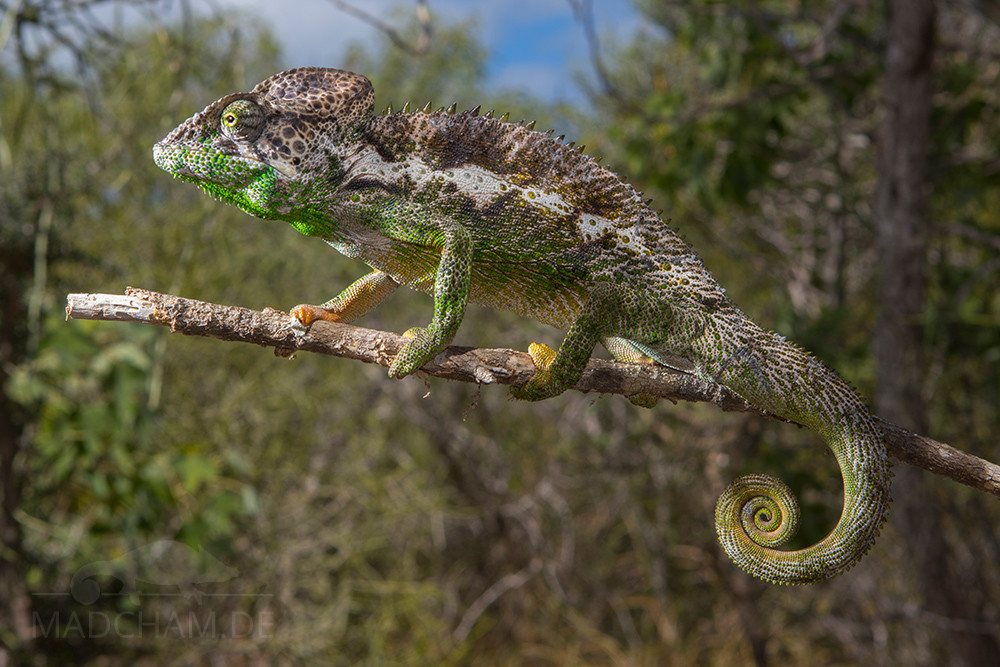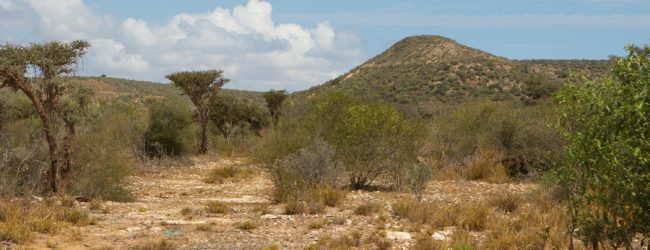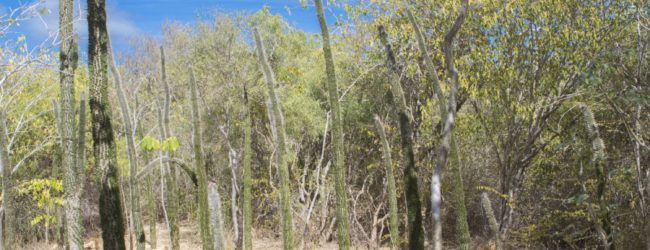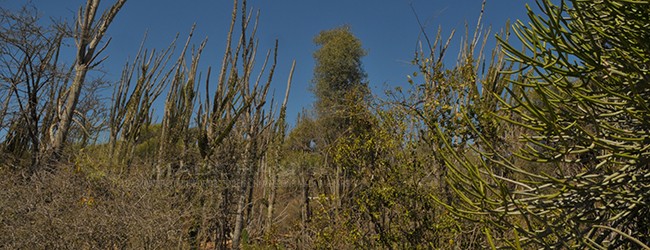2011-24 each 2000 specimens for legal export
First description:
(Cuvier, 1829)
Origin of the species name:
The French zoologist and palaeontologist Georges Léopold Chrétien Frédéric Dagobert Baron Cuvier founded the largest anatomical collection in Europe at the University of Paris (France). He named Furcifer verrucosus after the Latin verruca, which means warts. He used it to refer to the enlarged, “wart-like” scales on the body of animals.
Distribution:
Furcifer verrucosus lives in the dry, hot areas of south and west Madagascar. These chameleons can get along with relatively destroyed landscape and are often found in secondary vegetation but prefer spiny forests wherever possible.
Appearance and size:
They belong to Madagascar’s largest chameleons. Males of this species become up to 57 cm long, while females stay much smaller with total lengths of maximally 21 cm. Males have a high casque, females a little lower casque. Both genders have a gular crest, the males have a complete dorsal crest. In females, the dorsal crest is only visible in the anterior part of the body. Females wear simple brown colors with a lighter belly, sometimes also pretty red accents. Male Furcifer verrucosus are mostly grey-brown colored but may change to bright turquoise or grass green when with a white, interrupted lateral stripe when stressed. Due to many enlarged scales on the body, this chameleon is also known as “warty chameleon”.
Captivity:
Again and again, Furcifer verrucosus is for sale in captivity, but there are rarely serious breeding attempts. Probably, the situation is similar to Furcifer oustaleti which are not usually kept due to their large size and unspectacular color. Because of the distribution of Furcifer verrucosus mainly in south Madagascar, it is not as easy as in other species to imitate proper living conditions in captivity. Although they look similar to the extremely adaptable Furcifer oustaleti, they cannot be kept under the same climate conditions.
| Jan | Feb | Mar | Apr | May | Jun | Jul | Aug | Sep | Oct | Nov | Dec | |
| Average temperature | 27 | 27 | 26 | 25 | 23 | 21 | 20 | 21 | 22 | 23 | 25 | 26 |
| Minimum temperature | 22 | 22 | 21 | 20 | 17 | 14 | 14 | 15 | 16 | 18 | 20 | 22 |
| Maximum temperature | 32 | 32 | 32 | 30 | 28 | 26 | 26 | 27 | 28 | 29 | 30 | 31 |
| Rain days | 13 | 12 | 7 | 5 | 4 | 4 | 3 | 3 | 3 | 4 | 7 | 12 |
We have collected the data given above over several years with thermometers and hygrometers at the finding places of the chameleons. "Average temperature" means that values of a whole month have been calculated to one average value per month. For example all measured minimum temperature values of February have been calculated to one average minimum temperature for February. In plain language, this means single peak values of a day may be a little higher or lower than the average minimum and maximum temperatures. It is possible that a location has an average maximum temperature of 29°C, but one day during that month it had 33°C or even 35°C there.
Climate in Toliara (Tuléar) and surroundings is mainly one thing: Hot. In rainy season, daily temperatures rise easily to more than 30°C. In sunny places, it may even get 45°C. This is the location to look for every shady place you can get. And although it is called "rainy" season, precipitation in the south is lean. In good years, it is raining every couple of days from November to February. In worse years, it is raining even less.
During dry season, temperatures drop a little, but it remains very warm. In the night, temperatuers in July and August may drop even to 15°C, but days reach temperatures over 25°C without a problem. This large temperature drop is typical for the area. The dry season has only shot and very few rainfall.

We have measured UVB data with a Solarmeter 6.5 in spring (end of March) at the peak of activity of chameleons in Madagascar. We always measured the values that a chameleon could maximally reach in its habitat.
Habitat:
The habitat of Furcifer verrucosus consists of a spiny and dry forest that is green only during the rainy season. During the dry season, the whole region becomes grey and dries up. Where are residues of spiny forest, it is not very high but even more dense. Spiny plants, among them introduced Opuntia, are part of the majority of vegetation. In between are some Baobabs, too. Furcifer verrucosus also inhabits secondary vegetation such as bushes and shrubs on sand dunes and dried clay ground. During the dry season, many specimens die due to the harsh environmental conditions.
Hereinafter you can find some 360° pictures from Antsokay south of Toliara and Ifaty north of Toliara that we took during the rainy season. You can move inside these pictures via mouse click in all directions. If you click on the Theta logo, a new window with an enlarged view will open. You will also have the opportunity to look at the pictures in full-screen mode. Enjoy!
Dornwald im Reservat Reniala, Ifaty-Mangily, Region Atsimo-Andrefana, Süd-Madagaskar – Spherical Image – RICOH THETA
Dornwald im Reservat Reniala, Ifaty-Mangily, Region Atsimo-Andrefana, Süd-Madagaskar – Spherical Image – RICOH THETA
Dornwald im Reservat Antsokay, Region Atsimo-Andrefana, Süd-Madagaskar – Spherical Image – RICOH THETA
Dornwald im Reservat Antsokay, Region Atsimo-Andrefana, Süd-Madagaskar – Spherical Image – RICOH THETA
Dornwald im Reservat Antsokay, Region Atsimo-Andrefana, Süd-Madagaskar – Spherical Image – RICOH THETA































